Key takeaways:
- Public speaking is about connecting authentically with the audience, transforming a presentation into a meaningful dialogue.
- Pro-life advocacy emphasizes the dignity of every human life and encourages a cultural shift that supports life at all stages.
- Effective presentations utilize storytelling and audience engagement through questions, creating shared experiences that resonate deeply.
- Preparation, spontaneity, and vulnerability are essential, as authentic interactions can inspire others and foster understanding.
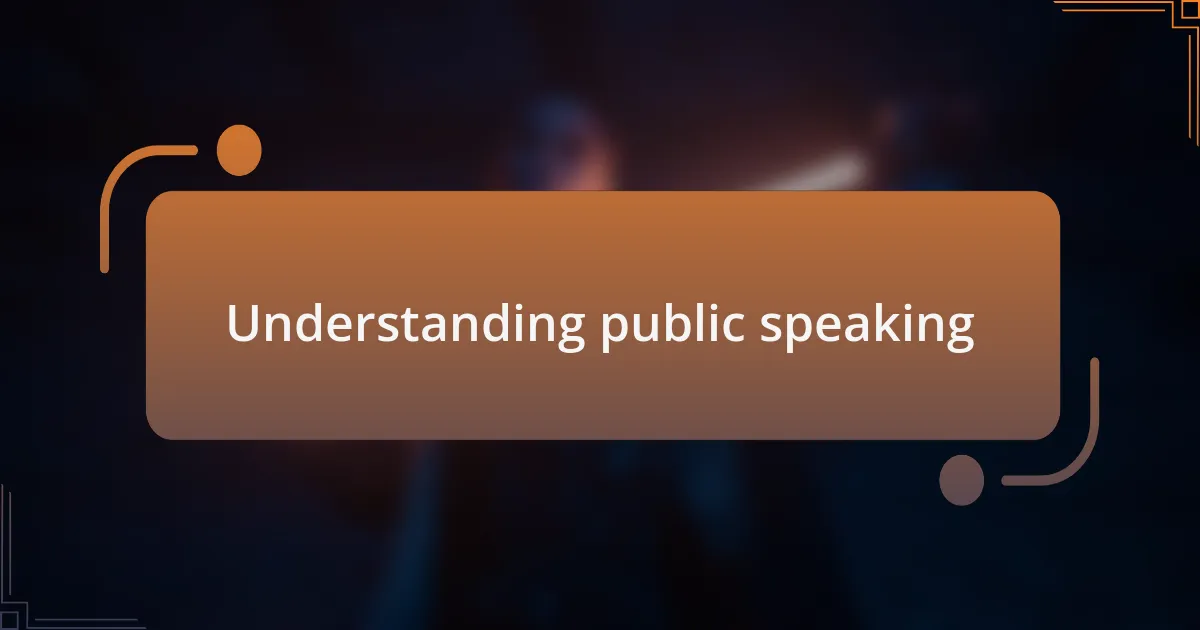
Understanding public speaking
Public speaking is more than just delivering a speech; it’s about connecting with your audience on a deeper level. I remember the first time I stood in front of a crowd to share my thoughts on a significant issue. My heart raced as I gazed at the expectant faces, but I realized that this vulnerability was what made the experience truly meaningful.
When you speak publicly, every word carries weight, and the way you present it can inspire or discourage. I often find myself questioning how my message resonates with the listeners. Are they nodding along, or are their eyes glazing over? Understanding the nuances of audience engagement can transform a simple presentation into a powerful dialogue that leaves a lasting impact.
It’s important to focus on clarity and authenticity in your message. I once spoke at a pro-life rally, and instead of sticking rigidly to my notes, I let my passion guide me. That authenticity not only eased my nerves but also created a genuine connection with the audience, reminding me that public speaking is as much about sharing your truth as it is about the art of communication.
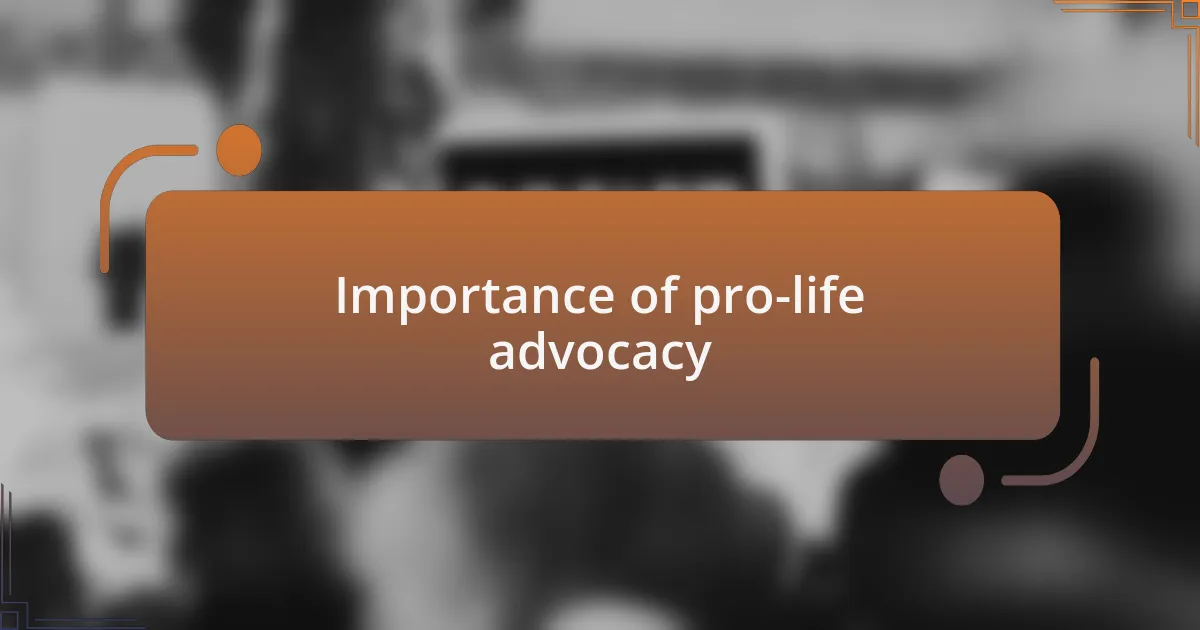
Importance of pro-life advocacy
Pro-life advocacy is crucial because it embodies a belief in the inherent dignity of every human life. I cannot emphasize enough how powerful it is to stand up for those who cannot voice their own dignity, especially the unborn. It often leaves me wondering, how can we truly call ourselves defenders of humanity if we ignore the most vulnerable among us?
Engaging in pro-life advocacy isn’t just about opposing abortion; it’s about fostering a culture that supports life in all its stages. When I advocate for this cause, I feel a deep sense of responsibility. I remember speaking at a community event where I shared stories of those positively impacted by a pro-life approach, and the audience’s emotional responses reinforced my belief that every conversation can change a perspective.
Moreover, pro-life advocacy encourages a comprehensive understanding of issues like adoption, maternal health, and support for families in crisis. I once met a woman who had chosen adoption for her child; her bravery inspired me, and I thought, what if we celebrated these choices more often? By promoting life-affirming solutions, we not only address the immediate concerns but also pave the way for a future that values compassion and understanding.
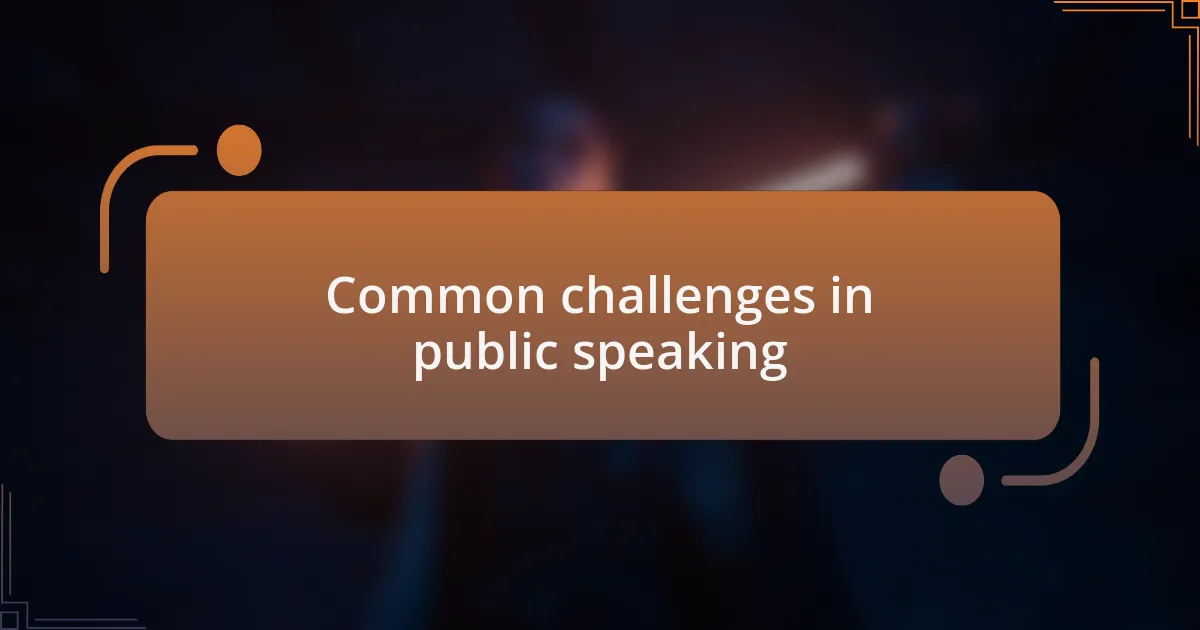
Common challenges in public speaking
One of the most significant challenges I face in public speaking is dealing with nervousness. That feeling of butterflies in my stomach can be overwhelming, especially right before I step up to the microphone. I often remind myself to take a deep breath and focus on the message rather than my anxiety; it truly helps to ground me in those moments.
Another hurdle is finding the right words to convey my passion effectively. During one of my talks, I remember struggling to articulate why every voice in this debate matters. It made me realize the importance of preparation. So, I started practicing by sharing smaller thoughts with friends beforehand; it not only boosts my confidence but also clarifies my message.
Engaging the audience can also be tricky. I recall a time when I felt a disconnect while speaking about a particularly emotional topic. It hit me that asking questions can bridge that gap. When I invite attendees to share their thoughts or stories, it transforms the atmosphere from one-sided to collaborative. After all, isn’t it our shared experiences that make our message resonate?
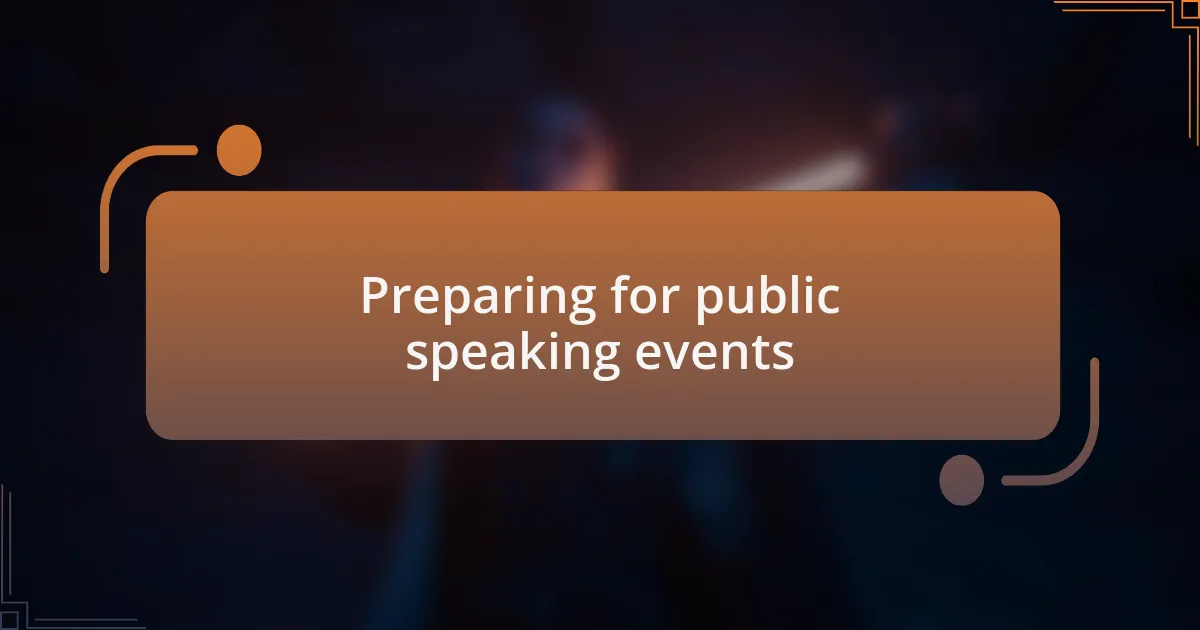
Preparing for public speaking events
Preparing for a public speaking event involves much more than just knowing your material; it’s about fostering a genuine connection with your audience. Before stepping onto the stage, I find it helpful to visualize the room and imagine engaging with the faces I’ll see. This visualization technique calms my nerves and prepares me to speak directly to the hearts of those present. Have you ever tried this? It might seem simple, but taking that moment to picture your impact can shift your mindset entirely.
I also believe in the power of rehearsal. Practicing in front of a mirror or with close friends allows me to refine my delivery. I recall a time when I rehearsed an important speech about the importance of life advocacy. The feedback I received not only improved my timing but also helped me discover the right emotional tones to emphasize. How can we not want that extra bit of insight before going live? It’s those little moments of practice that make a big difference in how my message is received.
Additionally, preparing my physical presence is vital. I always choose professional yet comfortable clothing that allows me to move freely. During one event, I wore a restrictive outfit that made me self-conscious instead of confident. It reminded me that my outward appearance can affect my inner demeanor. Have you ever found that what you wear influences your confidence? I know it does for me, and it’s another small step towards creating an impactful speaking experience.
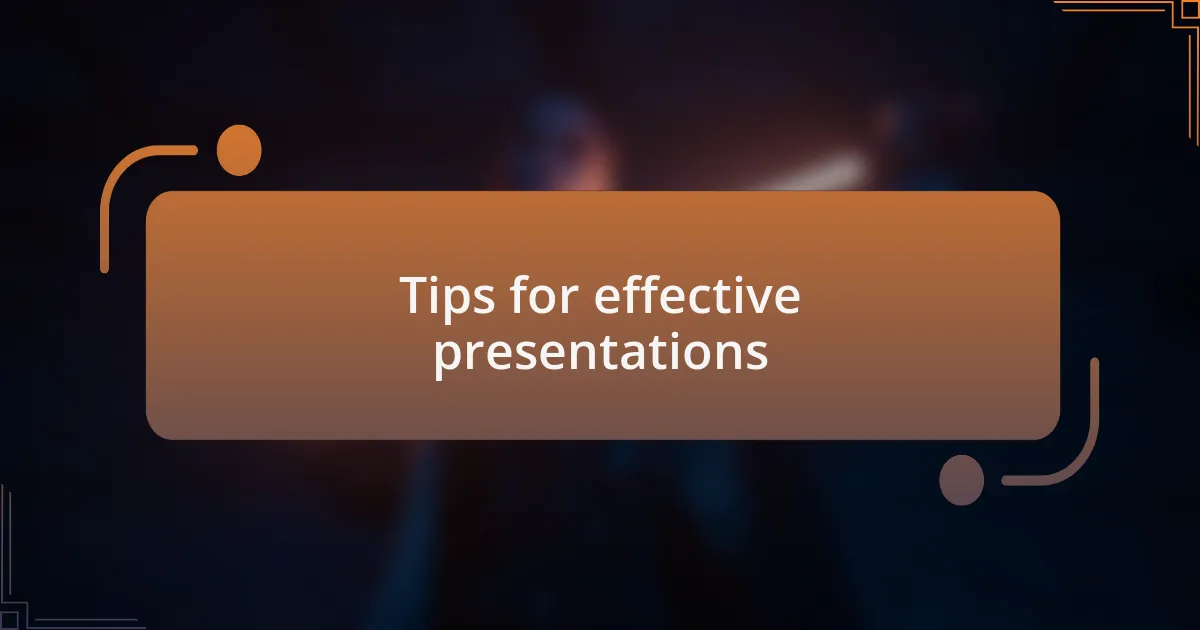
Tips for effective presentations
One of the key tips I’ve learned for effective presentations is to embrace storytelling. When I share a personal story related to pro-life advocacy, I watch as my audience leans in, their eyes sparkling with connection. It’s not just about facts; it’s about forming an emotional bridge. Have you ever noticed how a powerful story can leave a lasting impression? When I weave narratives into my speeches, it makes my message resonate on a deeper level.
Another important aspect is to engage with your audience through questions. I often make it a point to ask my listeners a thought-provoking question. For example, “What does the value of life mean to you?” I find that this sparks conversation and makes the audience feel involved. They aren’t just passive listeners; they’re active participants. This shift in dynamics not only boosts my confidence but also leads to a shared experience that enhances the entire presentation.
Lastly, the use of visuals can significantly aid in conveying your message. I was once at an event where visual aids transformed a basic topic into an engaging discussion. Simple graphs and heartfelt images can express what words alone sometimes cannot. Have you ever felt that a picture really was worth a thousand words? Integrating strong visuals can evoke emotions and drive points home with much greater impact, which is essential in advocacy work.
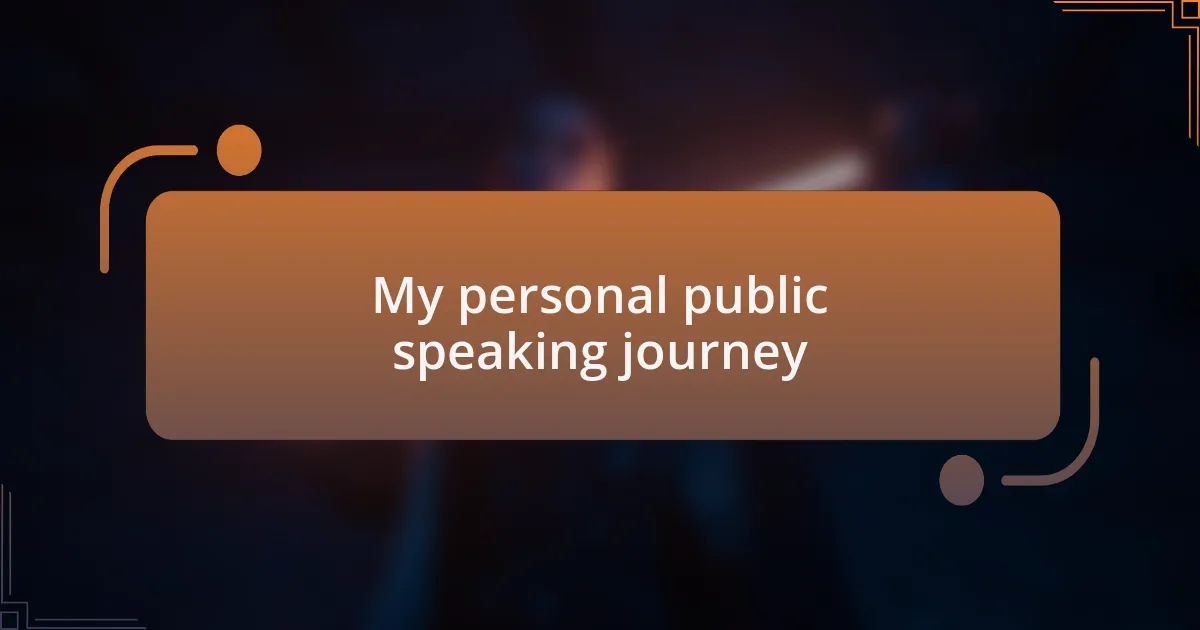
My personal public speaking journey
Public speaking has been a transformative journey for me. I remember my first time on stage, heart racing and palms sweaty, delivering a speech about the importance of advocating for life. To my surprise, the nervous energy became a catalyst for passion, and as I spoke, I found my voice. It felt empowering to share my beliefs.
As I navigated through various events, I encountered moments of vulnerability. There was a particular instance when I shared a story about a dear friend who faced immense difficulty during pregnancy. The room was silent, but in that silence, I felt a profound connection. It was as if my audience was honoring not just the story, but the shared experience of compassion and understanding. Have you ever felt that spark when you connect deeply with someone’s experience?
I learned that preparation is crucial, but spontaneity can be a gift. At times, I strayed from my scripted notes to address a question or share an impromptu thought. Those moments, though initially daunting, often led to genuine discussions that enriched my message. It’s gratifying to realize that the more I interact authentically, the more I inspire others to reflect on their own beliefs about life.
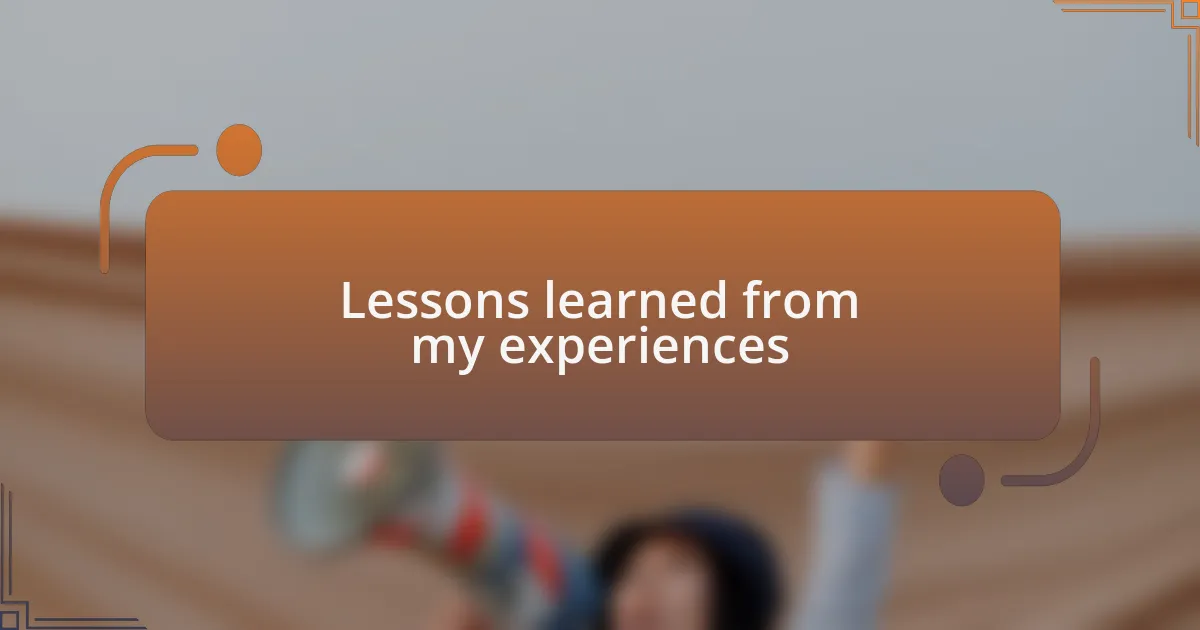
Lessons learned from my experiences
Public speaking has taught me that vulnerability can be a powerful tool. There was a time when I shared my own uncertainties about the pro-life stance during a panel discussion. As I spoke about my own doubts and the journey to clarity, I witnessed a shift in the room. It struck me then how authenticity not only disarms fear but also encourages others to share their stories. Have you ever noticed how a moment of honesty can break down barriers?
Another significant lesson I’ve learned is the importance of knowing my audience. I once prepared a speech that resonated well at one event, only to realize it didn’t connect with a different crowd. Adjusting my message on the fly taught me that empathy is essential in advocacy. The art of speaking isn’t just about delivering information; it’s about building relationships and finding common ground, isn’t it?
Finally, I’ve come to appreciate the role of feedback and reflection in improvement. After an event, I made it a habit to solicit responses from attendees. One time, a young woman approached me, expressing how my words inspired her to share her own story. That interaction showed me that every experience offers insights, whether through applause or constructive critique. Isn’t it fascinating how each moment can lead to personal and collective growth?